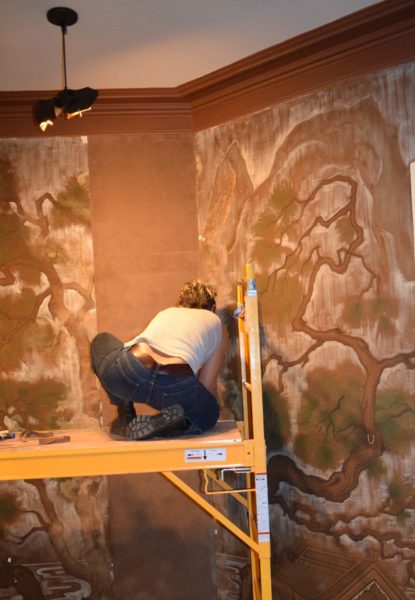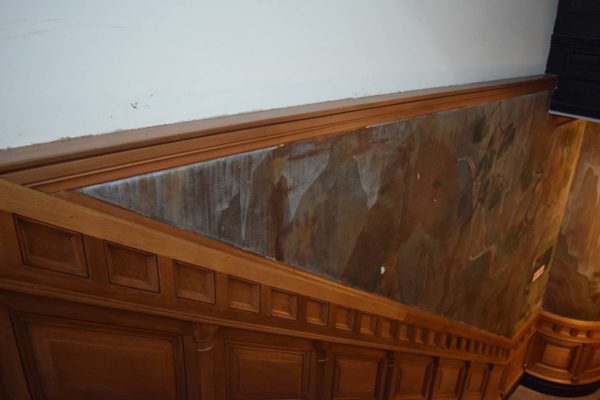Wilbraham 5th Ave NYC

The Wilbraham at 30th street and 5th Ave in New York City was built in 1888-1890 as a bachelor apartment hotel in Romanesque Revival architecture by David and John Jardine. It was remodelled in 1934-35 as residential when the current mural was apparently installed.
The plaster walls were lined with paper and then the linen was applied. The painting was done directly on to the linen apparently on site.

The mural looked decent at first glance but had suffered a multitude of damages over time.

The range of damages is listed but not limited to:
Water damage,staining,scratches,holes from signage and previous lighting, previously filled areas of loss with heavy enamel paint fills, graffitti and poor attachment

This project had budget restraints and needed a streamlined approach to address all stabilization and visual concerns with a finessed treatment proposal.

Further example of damaged mural

Further example of damaged mural

The next set of photos will illustrate our streamlined approach in this water damaged area.
The mural was dry cleaned. Areas beyond repair were traced for re-creation.

The removal of whole failing panels was neccessary in order to clean and prepare the substrate.
In some areas we could peel back a partial panel to clean and paste back.

This area was prepared with a new paper liner and matching linen.

The loss was filled in by Foreground partner John Lippert. His expertise at handling the infill relied on the surrounding image panels, the tracing of the damaged panel and photographs from our documentation efforts.

Further infill of missing imagery

In-painting complete.
The mural was not varnished originally and we chose to keep it that way. Any additional coating would have changed the overall color because of the absorptive quality of the open linen.The mural had survived as is since the 1930’s so it is a best practice to avoid adding another coating and keep it clean moving forward.

The next photo set is from a smaller area at the top of the stairs. The process for all removals and re-attachemnts match this set.
This area of concern had gotten a lot of human interaction.The two top most panels had been previously re-attached and repaired with many fills and enamel paint.

Removal of damaged panels and previous fills.

Verso of top panel showing liner paper attached.

Mechanical removal of original liner paper with a scalpel. As painstaking as this seems, it was entirely unavoidable.

Verso cleaned

Re-attachment of salvaged panels applied to liner paper.

Linen fills complete

In-painting on fills completed

The Team:
Our approach to this and most projects is to consider the historic intention and the use of the space going forward.We ask how we can contribute to the stabilization of the decoration with the minimum of intervention. Most often, during any one of our projects it looks like a disaster has hit, sometimes when we arrive it looks that way. Our ability to see and work through the chaos comes from hard work and experience.